Every marketing channel lives a different life. SEO is pretty stable but has to stay focused because of algorithm updates. Poor PPC can’t catch a break from all the Google Ads updates and privacy measures. And email marketing, well, at 43 years young and with an ROI of $36 for every $1 spent, it’s been living its best life.

But the smooth sailing has gotten rough since privacy patrol rolled into town (aka Apple iOS 15 and macOS Monterey) in September. With these latest privacy-first updates, there are a number of common email marketing tactics that have become ineffective and could even hurt your performance.
The thing is, it’s not clear what those tactics are, because you can still do them—it’s just that you will have inaccurate data to both carry out and measure the success of the strategy, which could lead to sending the wrong messages to your audience and ROI tanking. So read on to understand:
- Exactly what the iOS update entails
- How big the impact has been
- What strategies you should stop doing
- 13 strategies to implement instead
What is the iOS 15 update?
Apple’s iOS 15 update, released on September 20, 2021, provides two more privacy features for users—this time with email. There are two features marketers are concerned with:
- Hide My Email
- Mail Privacy Protection (MPP)
We’ll get into these two features shortly, but first, let’s get a big-picture look at some percentages in terms of who and what the update impacts.
How widespread is the impact of iOS 15 on email?
The level of concern with iOS 15 was initially low, since roughly only 33% of all emails in the U.S. are opened on an iPhone. But on October 25, macOS Monterey was released, which offers the same above features for Apple computers and laptops. So if we look at the data from Q1 2021 by Litmus, there is reason for concern.
Apple mail dominates, capturing 58% of emails on desktop and 90% on mobile:
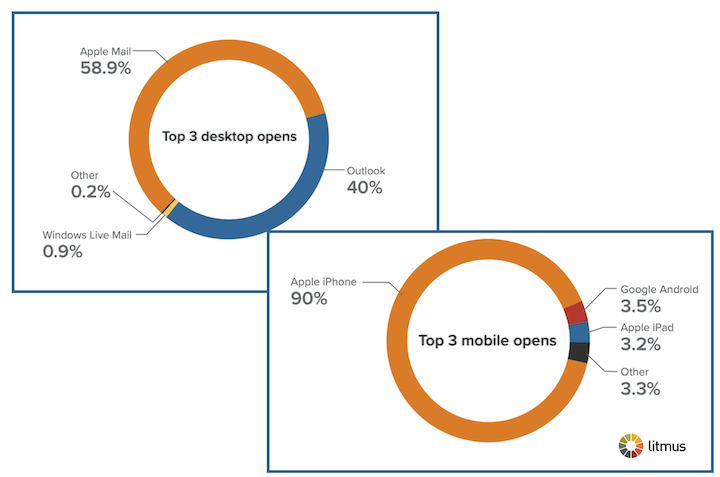
However, the percentage of webmail opens is almost double that of desktop and only seven percentage points behind mobile.
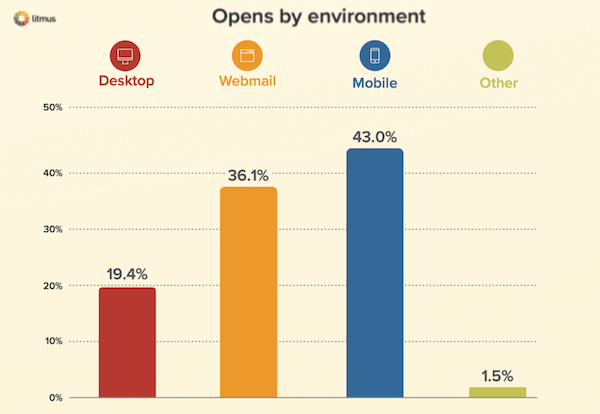
And the most popular webmail client? Gmail. Apple’s webmail (iCloud Mail) isn’t even on the map.
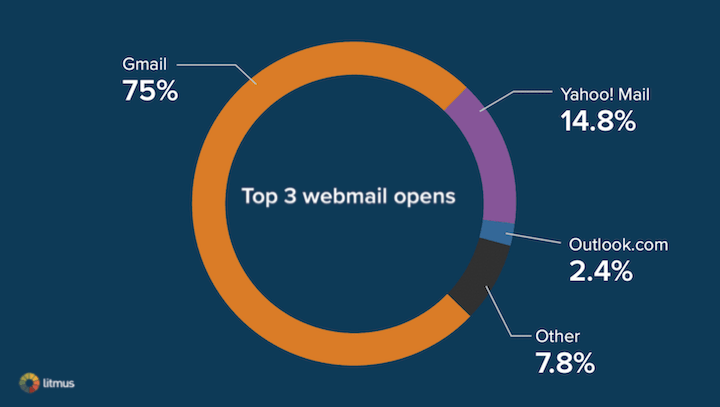
Even still, with 62.4% of all emails being opened on Apple-dominated mobile and desktop vs 36% being opened in Gmail-dominated webmail, there is reason for concern, but not panic. Read on to find out why.
Hide My Email
Hide My Email allows users to share a made-up email address in forms and registrations, which will route messages to their inbox without showing the email sender the actual name of the address. This option appears when you choose “Sign in with Apple” or if you’re an iCloud+ user on Safari.

The impact of Hide My Email on (not just) email marketing
First and foremost, users can make as many proxy/fake email addresses as they want. If a user changes or deletes a proxy address, they can inadvertently cut themselves off from whatever service they subscribed to using that proxy, leaving the sender with a hard bounce and no unsubscribe information.
Also, email addresses are often used as the unique identifiers in automation platforms and CRMs that help businesses tailor their marketing and customer service accordingly. So if you send a promotional email about your app to a list of leads and someone on that list signs up for the app using a proxy address, your email automation program will not know to remove that person from the nurture flow. The person will continue receiving marketing emails for something they already signed up for, causing you to appear like you don’t know your customers and them to most likely unsubscribe.
Or let’s say they call in for customer service. If they give their real email address to help the representative locate their account, it will be nowhere to be found.
What to do
There are big implications here for more than just email marketing, but luckily, according to Admonsters, only paid iCloud+ account holders using Safari can use Hide My Email in a web form, and fortunately, less than 20% of people worldwide use Safari.
Another reason not to panic is that these settings are opt-in, and if the user has gone so far as to click on your sign-up button, it’s likely they trust you enough to use their real email address.
However, you will want to use an alternative unique identifier in your marketing ecosystem to future-proof your strategy.
Mail Privacy Protection (MPP)
To understand MPP, you must first understand that the reason email automation platforms are able to give you open-related data is that they include a pixel in every email you send. The pixel gets downloaded when the email is downloaded (opened) and then communicates back to the platform if and when a person opened the email, how many times they opened it, and their IP address.
Mail Privacy Protection is designed to prevent the pixel from being downloaded on your device, so emailers can’t see your activity or identify your location.
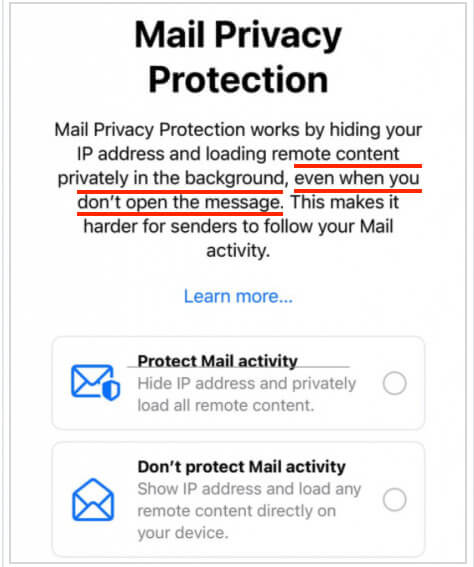
Just like with iOS 14’s App Tracking Transparency, Apple is once again wedging itself between the user and the third-party tools marketers need to accurately measure—and personalize—their strategy. (If you’re still struggling with Facebook ads, try out these post-iOS update Facebook ad strategies.)
The impact of Mail Privacy Protection on email marketing
The MPP adoption rate was 20% as of October 1 (10 days after iOS 15 rolled out). A month later, Constant Contact shared in this Litmus post that average email open rates in the month before AND after iOS 15 were steady at 17.6%. However, by November 17, MPP adoption had grown to 30%. Another source shares that as of now, 60% of Apple users have installed iOS 15, and 97% of those users have adopted MPP. So there is potential here that the impact of iOS 15 on email marketing performance will grow over time.
So what exactly is that impact? Let’s explore…
Inflated open rates
You might think that you’ll see lower open rates because the pixel is being blocked from getting downloaded, but this is not the case. Emails will still contain a pixel, the email will just now go to a proxy server first (instead of right to your device) where the content gets downloaded—which means also the pixel. That content then goes into the Apple Privacy Cache so that should you decide to open the email, you’ll be viewing the cached content and not actually downloading the original email with the pixel.
So what this means is, the email—and therefore the pixel—gets downloaded by the proxy server regardless of whether the recipient opens it (hence the red underline above), causing inflated open rates.
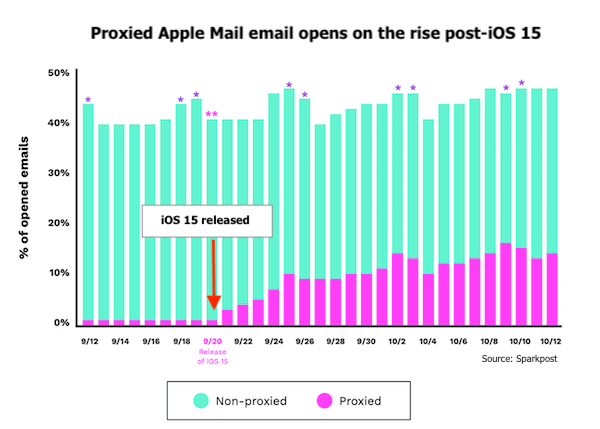
Email marketing strategies hindered by MPP
With inaccurate and incomplete data on opens, IP addresses, and devices, several email marketing strategies become unreliable or ineffective. This includes but is not limited to:
- List hygiene, like removing or re-engaging contacts based on last opened date.
- Sending the same email a few days later to those in a group who did not open the first email.
- Email segmentation strategies, as segments might shrink or become inaccurate.
- Subject line testing based on open rates.
- Send time optimization (unless your email provider adjusts its algorithm to exclude opens).
- Real-time personalization like countdown timers and live content (the email will display the content cached at the time the proxy server opened the email, not at the time the user opens it).
- Dynamic elements like including a link to Google Play or App Store depending on device that opened the email.
- Trigger emails and nurture flows activated by opens.
- Location-based personalization, like local weather or nearby stores.
What to do
As the impact of Mail Privacy Protection is likely to grow over time, consider employing some of these strategies:
Break up with open rates
- Look at other metrics: Just as click-through rate doesn’t paint the whole picture in ad campaigns, open rate isn’t everything for emails. Focus instead on clicks on links in your email, purchases and conversions, and bounces, and unsubscribes.
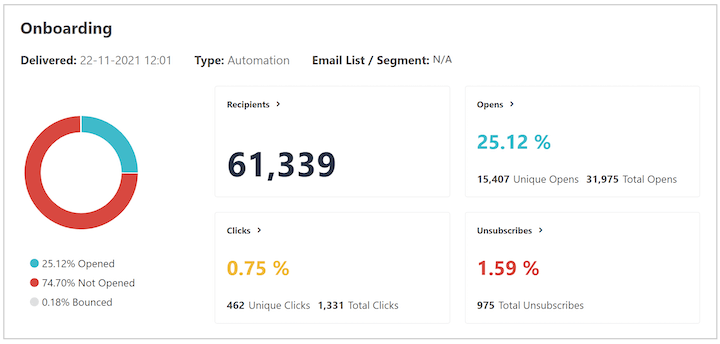
- Rebuild open-based campaign flows: Create new rules for open-based trigger flows and segmentation strategies to instead focus on clicks or purchases. On that note, pause existing campaigns, clone them, and then make adjustments to the clones so you can keep historical data.
- Test body components: Instead of testing subject lines, test out elements in the body of your content. (Head here for newsletter content ideas.)
Keep your lists in shape
- Get quality signups: With open rates becoming less reliable, the strategy of collecting as many email addresses as you can and then refining your list and your content based on performance is going to become less effective. Use the right information and email calls to action to attract the most qualified email signups in the first place.
- Run regular re-permission campaigns: On that note, keep your list refined to only your most engaged and interested readers so you can be sure your content performs its best.
- Segment by device: Use historical data to segment your Apple users out so you can adjust your strategy or email content accordingly.
Employ a mix of marketing strategies
- Don’t rely solely on email: Email better not be your only marketing channel! Invest in a mix of marketing strategies so you can be driving multiple goals through multiple channels. This way you can stand strong against major changes like this.
- Use data from other channels: Take multi-channel marketing a step further into cross-channel marketing—where you integrate the channels to build a widespread and consistent online presence, and also use performance on one channel to inform your strategies on another. Apply insights from your social media, website, and advertising analytics to refine your email personas and make data-driven assumptions about the best content to send and when.
Collect zero party data
- First-party data is good: This is where you use email engagement (rather than just email opens) and website and purchase activity to gather insights on your audience.
- Zero-party data is better: Litmus suggests creating preference centers so subscribers can directly tell you the information you’d normally infer through pixel data—like location, interests, and how frequently they want to be emailed.
Have a content strategy
- Build trust: Provide useful content, a solid customer experience, clear copy, and social proof so people willingly give you their real email address.
- Add value: You can optimize campaigns based on metrics and behaviors, but at the end of the day, it all comes down to whether or not the reader is getting value from your content. This is your priority! Make sure you have a content strategy and maybe even a content marketing mission statement.
- Write great copy: Similar to that last suggestion—you won’t need to rely as heavily on testing if you have great email copywriting or creative newsletters to begin with.
Privacy-proof your email marketing strategy
Email marketing is about 43 years old—quite the OG! So no, it is not going away anytime soon, but just as advertisers have had to adapt with iOS 14 privacy updates, so, too, will email marketers have to roll with the iOS 15 flow. Mail Privacy Protection is a much bigger concern than Hide My Email, but with the strategies listed above, you can ensure continued success into 2022 and beyond.
The post 9 Popular Email Marketing Strategies to Stop Doing ASAP (+13 to Do Instead) appeared first on WordStream.




Recent Comments